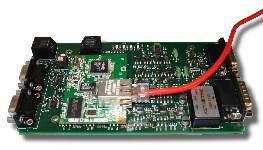
This paper describes a method, refered to here as Net106, to encode and transport individual IRIG 106 Ch 10 data channels over a connectionless datagram network transport. A method involving UDP/IP is described but any network datagram protocol can be accommodated. The purpose of this method is to allow multiple seperate data channels to transmit their data to 1) a single receiver in the case of unicast, or 2) multiple receivers in the case of multicast, and have the reciever reconstruct the multiple data sources into a valid IRIG 106 Ch 10 data stream for storing or display.
Traditional instrumentation consists of a recorder box with various types of hardware interfaces integral with the recorder and recording medium. The traditional instrumentation approach has several drawbacks.

This
paper describes a distributed instrumentation architecture where each data
channel is implemented as a node on a suitable network (like Ethernet) and uses
connectionless datagrams (like UDP) to transport data. Typically data
interfaces are implemented using a small dedicated network aware processor such
as those offered by Rabbit Semiconductor and Netburner. In a lab environment data interfaces can be
inexpensive personal computers with the appropriate hardware interface. These
data channel network nodes transmit data to one or more receivers which can then
record, decode and display, and/or resend the data.

Benefits of this architecture include:
Key goals of this propose architecture are:
In this proposed method, the basic unit of information is a standard IRIG 106 Ch 10 data packet consisting of a Ch 10 header and data payload sections. All network datagram packets begin with an identifying header. Ch 10 data structures within the datagram are guaranteed to "line up" with the beginning of a packet boundary. In other words, the Net106 method described is not a streaming method with no notion of internal Ch 10 data structure. Instead the integrity of Ch 10 data structures is preserved within a single data packet. This allows easy decoding and display in real time.
For Ch 10 data packets that are small enough to fit into a single datagram (usually 32k for UDP, but sometimes as small as 8k) the entire Ch 10 packet can be transmitted in the datagram as-is with no additional header or other data overhead. See Figure 1 below for the datagram packet layout. A Net106 datagram that is the beginning of a Ch 10 packet is recognised by the standard Ch 10 packet sync pattern value of 0xEB25, refered to here as HEADER SYNC PATTERN. As a minimum, this first Net106 packet should contain a complete Ch 10 header and optional secondary header, as well as the channel specific data portion for data type. If the data portion of the packet is small enough it can follow the channel specific data field in the datagram packet.
In many cases, though, a complete Ch 10 data packets is too big to fit into one datagram packet. In this case a method to fragment large Ch 10 packets across multiple datagrams is proposed. This is accomplished by splitting the data portion of the Ch 10 packet into smaller units. The first datagram contains a standard Ch 10 header and channel specific data. Subsequent datagrams are prefixed with a uniquely identifying header. See Figure 2 below for datagram packet layout. A Net106 datagram that is a subsequent data packet is recognised by a packet sync pattern value of 0xEB26, refered to here as the DATA SYNC PATTERN.
In general a Ch 10 data packet body consists of multiple data messages. The Ch 10 data packet body must be split at the boundary between data messages. In other words, a subsequent Net106 data message would always have a Net106 header followed by the standard Ch 10 Intra-Packet Header, followed by the complete data message. This allows data decode and display applications to process a received Net106 datagram without having to "string together" two datagrams to get a complete data message.
Net106 data datagram messages contain the same Channel ID and Sequence number values as in the associated header. Data messages also have a Sub-sequence number starting at zero and incremented by one to permit in-order reassembly and dropped packet detection.
| msb 31 |
16 | 15 | lsb 0 |
|
| CHANNEL ID | HEADER SYNC PATTERN | Header Packet Header (same as Ch 10 header) | ||
| PACKET LENGTH | ||||
| DATA LENGTH | ||||
| DATA TYPE | PACKET FLAGS | SEQUENCE NUMBER | HEADER VERSION | |
| RELATIVE TIME COUNTER | ||||
| HEADER CHECKSUM | RELATIVE TIME COUNTER | |||
| TIME (LSLW) | (Optional) Secondary Header | |||
| TIME (MSLW) | ||||
| SECONDARY HEADER CHECKSUM | RESERVED | |||
| CHANNEL SPECIFIC DATA : |
||||
All Net106 Header datagram fields are identical to the corresponding IRIG 106 Ch 10 data fields.
| msb 31 |
16 | 15 | lsb 0 |
|
| CHANNEL ID | DATA SYNC PATTERN | Data Packet Header | ||
| DATA TYPE | SEQUENCE NUMBER | SUB-SEQUENCE NUMBER | ||
| INTRA-PACKET HEADER 1 | ||||
| DATA MESSAGE 1 | ||||
| INTRA-PACKET HEADER 2 | ||||
| DATA MESSAGE 2 | ||||
| : | ||||
| INTRA-PACKET HEADER n | ||||
| DATA MESSAGE n | ||||
Net106 Data Datagrams have the following header fields: